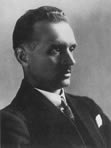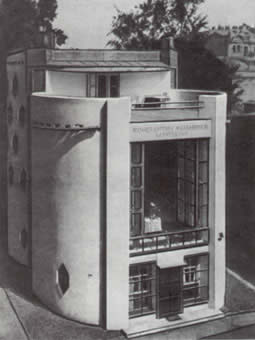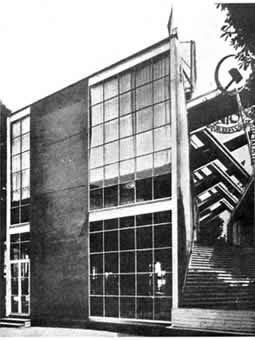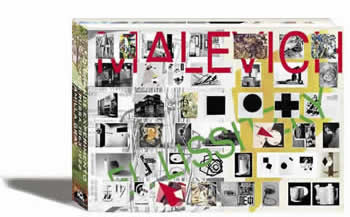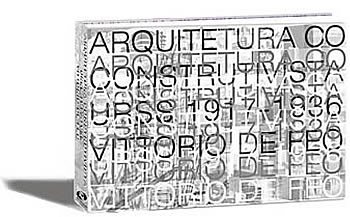|
The seventy-fifth birthday of Konstantin
Stepanovich Melnikov, one of the founders of Soviet architecture,
was celebrated by Moscow architects with an evening in his honour
and a large exhibition of his work.
In the history of the architecture
of the 1920s and early 1930s, Melnikov has become well known for his
creative work, which perhaps shows the brilliance and almost grotesque
refinement of expression of one deeply involved in the conflicting
architectural tendencies of his day. He has been exalted and he has
been denigrated and the reverberations of these arguments resound
to this day. However, for the main part the animosity occasioned by
the name of Melnikov is founded upon misunderstandings and prejudices
strengthened by the passage of time, although their basis has long
disappeared.
Today it is possible to review Melnikov's
creative development objectively. The logic of this material will
oblige critics to recognize the partial and personal nature of their
attitudes. I myself cannot claim in this essay to present an impartial
assessment or detailed review of the merits and deficiencies of all
the products or even of all the periods of Melnikov's work. This essay
is rather an attempt to describe the particular character of his architectural
thought.
Melnikov completed his studies at
the Moscow College of Painting, Sculpture and Architecture in 1917.
Like everyone else he produced, as part of his studies, projects for
halls in the Roman style, Neoclassical railway stations, and churches
in the Russian style. The student Melnikov of 1916 and the young architect
Melnikov at the beginning of the 1920s had very little in common.
Melnikov was among the first architects
to seek new forms in response to the demands of new undertakings.
The 1920s favoured fantasy. The Revolution, which had opened up new
areas of thought, gave an extraordinarily powerful boost to creative
activity, although in the first instance only rarely providing opportunities
for the execution of projects as real buildings.
A
period of 'paper' innovations began. Whole stages in the
development of architectural thought culminated in series of
|
O
septuagésimo-quinto aniversário de Konstantin Stepanovich Melnikov,
um dos fundadores da arquitetura Soviética, foi celebrado pelos arquitetos
de Moscou com uma noite em sua homenagem e uma grande mostra de seu
trabalho.
Na
história da arquitetura dos anos de 1920 e do início
dos anos de 1930, Melnikov tornou-se bem conhecido pelo seu trabalho
criativo, que, talvez, mostre um brilhantismo e um requinte de expressão,
quase grotesco, de alguém profundamente envolvido nas conflituosas
tendências arquitetônicas de sua época. Foi exaltado
e foi denegrido e as reverberações desses argumentos
ressoam até nossos dias. Entretanto, na sua maior parte, a
animosidade ocasionada pelo nome de Melnikov é fundada em mal-entendidos
e preconceitos reforçados pela passagem do tempo, ainda que
seu embasamento tenha, de há muito, desaparecido.
Hoje
é possivel rever, objetivamente, o desenvolvimento criativo
de Melnikov. A lógica desse material obrigará os críticos
a reconhecerem a natureza parcial e pessoal de suas atitudes. Eu mesmo
não posso alegar que esse ensaio apresente uma avaliação
imparcial ou uma revisão detalhada dos méritos e deficiências
de toda a produção ou mesmo de todos os períodos
da obra de Melnikov. Esse ensaio é, sobretudo, uma tentativa
de descrever o caráter particular de seu pensamento arquitetônico.
Melnikov
completou seus estudos na Faculdade de Pintura, Escultura e Arquitetura
de Moscou, em 1917. Como todo mundo, ele produziu, como parte de seus
estudos, projetos para salões em estilo romano, estações
ferroviárias neoclássicas e igrejas em estilo russo.
O estudante Melnikov, de 1916, e o jovem arquiteto Melnikov, do início
dos anos de 1920, tinham muito pouco em comum.
Melnikov foi um dos primeiros arquitetos a buscar novas formas em
resposta às exigências das novas tarefas. Os anos de
1920 favoreceram a fantasia. A revolução, que tinha
ampliado novas áreas do pensamento, deu um impulso, extraordinariamente
poderoso, à atividade criativa, apesar de, num primeiro momento,
só fornecer, raramente, oportunidades para a execução
de projetos de edifícios verdadeiros.
Um período de inovações no ‘papel’
começara. Etapas inteiras na evolução do pensamento
arquitetônico culminaram em séries de
|
(page
58) unexecuted projects. Tatlin's Monument
to the Third International has remained a famous monument of this
period, foreshadowing an era of dynamic industrial architecture. But
in itself it is a fantasy remote from the practical demands of the
difficult war years. In many ways Melnikov prolonged this very line
of industrial romance, but he was distinguished by his extraordinary
vigour in dealing with practical necessities. Few of the leading Soviet
architects of the time built as much as Melnikov – or embodied
in brick and glass so many fantastic and paradoxical concepts.
However,
his first practical projects were of necessity modest temporary structures
in wood. He began with exhibition architecture, a metier to which
his talent was sympathetic. His inclination towards experiment, towards
maximum refinement of architectural form, his acute sense of formal
balance, the complex and dynamic way in which he interlocked exterior
and interior space in a building – all of these factors gave
his pavilions a vigour and expressiveness particularly appropriate
to an exhibition context.
The All-Russia
Agricultural and Craft Exhibition held in 1923 constituted the first
review of Soviet architecture. This provided an opportunity for the
public to see in the form of actual buildings what remained of the
previous epoch and what was born of the new. As the pavilions were
both light and temporary, the architects were able to experiment freely
and employ daring ideas.
The pavilion
for Makhorka tobacco (one of the less important pavilions) fell to
the young Melnikov. It attracted attention, however, and people began
to talk about him. The ideas initiated here appeared fully developed
two years later in the famous pavilion for the Paris Exhibition of
Decorative Arts in 1925. The Parisian pavilion was clearer, cleaner
and better proportioned, but its main ideas were already in evidence
in 1923. The materials of the earlier pavilion, wood and glass, are
simple and traditional but reconsidered with unconventional results.
Glass spans the corners and the upper storey is cantilevered; on an
exterior corner is inserted a spiral staircase. Simple geometric forms
have been combined in a sophisticated complex. As in later works Melnikov
here makes great use of inscriptions which run diagonally and employ
uneven lettering of differing sizes.
Perhaps
the only rival to Melnikov's Soviet pavilion at the 1925 Paris Exhibition
of Decorative Art was Le Corbusier's Pavillon de L'Esprit Nouveau.
While this was distinguished by a certain logical clarity, Melnikov's
aspired to something of the impact of a poster, with its vigorous
colours, decorative lettering and emblems, and
|
(página
58) projetos não
executados. O Monumento da Terceira Internacional, de Tatlin, permanece
como um famoso monumento desse período, prefigurando uma era
de dinâmica arquitetura industrial. Mas, no seu âmago,
é uma fantasia distanciada das exigências práticas
dos difíceis anos da guerra. De muitas maneiras, Melnikov prolongou
essa linha típica do romance industrial, mas se destacou por
seu extraordinário vigor em lidar com as necessidades práticas.
Poucos, dentre os principais arquitetos soviéticos da época,
construiram tanto quanto Melnikov – ou materializaram em tijolo
e vidro tantos conceitos fantásticos e paradoxais.
Entretanto,
seus primeiros projetos práticos foram, necessariamente, modestas
estruturas provisórias de madeira. Começou com arquitetura
de exposições, um métier para o qual
seu talento era afim. Sua inclinação para o experimento,
para o máximo refinamento da forma arquitetônica, seu
agudo senso de equilíbrio formal, a maneira complexa e dinâmica
na qual ele integrava o espaço exterior e o interior em um
edifício – todos esses fatores davam, aos seus pavilhões,
um vigor e uma expressividade particularmente apropriados ao contexto
das exposições.
A
Exposição Nacional de Agricultura e Artesanato, organizada
em 1923, constitui-se na primeira revisão da arquitetura soviética.
Deu ao público a oportunidade de ver, na forma de construções
reais, o que se manteve da época anterior e o que nascia na
nova. Como os pavilhões eram, ao mesmo tempo, leves e temporários,
os arquitetos puderam experimentar livremente e empregar idéias
arrojadas.
O pavilhão para a fábrica de tabaco Makhorka (um dos
pavilhões menos importantes) coube ao jovem Melnikov. Entretanto,
despertou a atenção das pessoas que começaram
a falar dele. As idéias aqui iniciadas apareceram completamente
desenvolvidas, dois anos mais tarde, no famoso pavilhão para
a Mostra de Artes Decorativas de Paris, em 1925. O pavilhão
parisiense era mais claro, mais limpo e mais bem proporcionado, mas
suas idéias principais já eram evidentes em 1923. Os
materiais do pavilhão primitivo, madeira e vidro, são
simples e tradicionais mas reavaliados com resultados originais. Vidros
recobrem os cantos e o andar superior é em balanço;
em um canto exterior está inserida uma escada espiral. Formas
geométricas simples foram combinadas num complexo sofisticado.
Como nos trabalhos futuros, Melnikov, aqui, faz grande uso de incrições
que correm diagonalmente e emprega letras desiguais de tamanhos diversos.
Talvez o único rival do pavilhão soviético de
Melnikov na Mostra de Artes Decorativas de Paris, de 1925, foi o Pavillon
de L’Esprit Nouveau de Le Corbusier. Enquanto este se distinguia
por uma certa claridade lógica, o de Melnikov aspirava a algo
com o impacto de um poster, com suas cores vigorosas, letras e emblemas
decorativos, e |
| (page
60) expansive composition. The simple volume of the pavilion's
rectangular plan was split by diagonal staircases. These abruptly
denied the simplicity of the building which to all intents and purposes
the architect had already based on the 'logic of the right angle'.
Above, the roof-like awnings of the stairs soared like wings, and
above that were the letters for USSR in red. For all Melnikov's apparently
elementary approach, his buildings reveal a considerable complexity.
The staircase was decoratively shaded above by awnings, though not
enclosed in the normal sense of the word. It captured within the pavilion
the broad flow of external space. Its daring dynamics, the frank simplicity
of its materials and the lightness of the pavilion, as well as its
rapid erection, stood in contrast to the theatrical monumentality
of neighbouring pavilions.
(english
version: John Milner)
|
(página
60)composição expansiva. O volume simples da
planta retangular do pavilhão era fendido por escadarias diagonais.
Estas negavam, abruptamente, a simplicidade do edifício que,
em todas as intenções e propósitos, o arquiteto
já havia embasado na ‘lógica do ângulo reto’.
Acima, os brise-soleil de cobertura dos degraus planavam como asas,
e acima deles estavam as letras de URSS em vermelho. Apesar de todo
enfoque, aparentemente elementar, de Melnikov, seus edifícios
revelam uma complexidade considerável. A escadaria foi decorativamente
sombreada, por cima, pelos brise-soleil de cobertura, mas não
confinada no sentido normal da palavra. Assim, capturou para dentro
do pavilhão, um largo fluxo de espaço externo. Sua dinâmica
ousada, a franca simplicidade de seus materiais e a leveza do pavilhão,
como também sua rápida montagem, contrastou com a monumentalidade
teatral dos pavilhões vizinhos.
versão
para o português:
L. A. Pitanga do Amparo
09/12/2000 |
